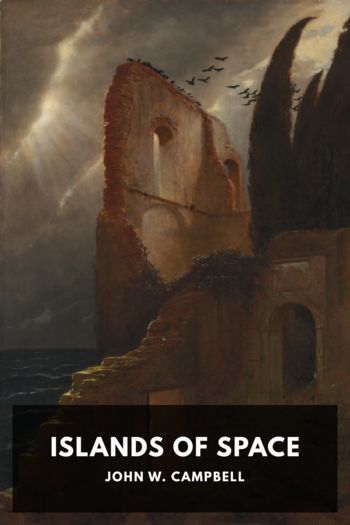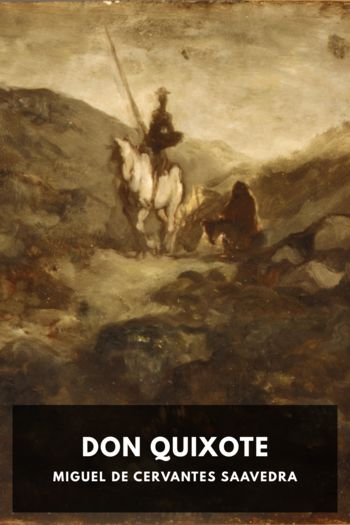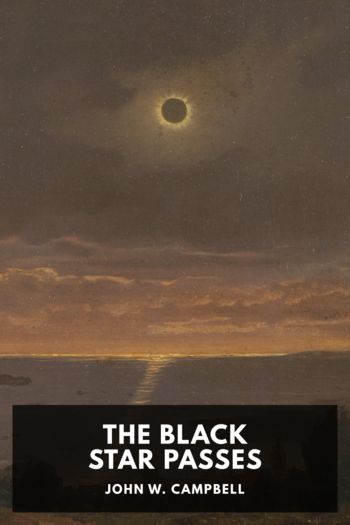Islands of Space, John W. Campbell [self help books to read TXT] 📗

- Author: John W. Campbell
Book online «Islands of Space, John W. Campbell [self help books to read TXT] 📗». Author John W. Campbell
When they finally got what they were looking for, Morey gazed steadily at the image. “Now the job is to figure the distance. And we haven’t got much parallax to work with.”
“If we compute in the timing in our blinker system at opposite sides of the orbit, I think we can do it,” Arcot said.
They went to work on the problem. When Fuller and Wade showed up, they were given work to do—Morey gave them equations to solve without telling them to what the figures applied.
Finally Arcot said: “Their period about the common center of gravity is thirty-nine hours, as I figure it.”
Morey nodded. “Check. And that gives us a distance of two million miles apart.”
“Just what are you two up to?” asked Fuller. “What good is another star? The one we’re interested in is this freak underneath us.”
“No,” Arcot corrected, “we’re interested in getting away from the one beneath us, which is an entirely different matter. If we were midway between this star and that one, the gravitational effects of the two would be cancelled out, since we would be pulled as hard in one direction as the other. Then we’d be free of both pulls and could escape!
“If we could get into that neutral area long enough to turn on our space strain drive, we could get away between them fast. Of course, a lot of our energy would be eaten up, but we’d get away.
“That’s our only hope,” Arcot concluded.
“Yes, and what a whale of a hope it is,” Wade snorted sarcastically. “How are you going to get out to a point halfway between these two stars when you don’t have enough power to lift this ship a few miles?”
“If Muhammad can not go to the mountain,” misquoted Arcot, “then the mountain must come to Muhammad.”
“What are you going to do?” Wade asked in exasperation. “Beat Joshua? He made the sun stand still, but this is a job of throwing them around!”
“It is,” agreed Arcot quietly, “and I intend to throw that star in such a way that we can escape between the twin fields! We can escape between the hammer and the anvil as millions of millions of millions of tons of matter crash into each other.”
“And you intend to swing that?” asked Wade in awe as he thought of the spectacle there would be when two suns fell into each other. “Well, I don’t want to be around.”
“You haven’t any choice,” Arcot grinned. Then his face grew serious. “What I want to do is simple. We have the molecular ray. Those stars are hot. They don’t fall into each other because they are rotating about each other. Suppose that rotation were stopped—stopped suddenly and completely? The molecular ray acts catalytically; we won’t supply the power to stop that star, the star itself will. All we have to do is cause the molecules to move in a direction opposite to the rotation. We’ll supply the impulse, and the star will supply the energy!
“Our job will be to break away when the stars get close enough; we are really going to hitch our wagon to a star!
“The mechanics of the job are simple. We will have to calculate when and how long to use the power, and when and how quickly to escape. We’ll have to use the main power board to generate the ray and project it instead of the little ray units. With luck, we ought to be free of this star in three days!”
Work was started at once. They had a chance of life in sight, and they had every intention of taking advantage of it! The calculating machines they had brought would certainly prove worth their mass in this one use. The observations were extremely difficult because the ship was rocketing around the star in such a rapid orbit. The calculations of the mass and distance and orbital motion of the other star were therefore very difficult, but the final results looked good.
The other star and this one formed a binary, the two being of only slightly different mass and rotating about each other at a distance of roughly two million miles.
The next problem was to calculate the time of fall from that point, assuming that it would stop instantaneously, which would be approximately true.
The actual fall would take only seven hours under the tremendous acceleration of the two masses! Since the stars would fall toward each other, the ship would be drawn toward the falling mass, and since their orbit around the star took only a fraction of a second to complete, they had to make sure they were in the right position at the halfway point just before collision occurred. Also, their orbit would be greatly perturbed as the star approached, and it was necessary to calculate that in, too.
Arcot calculated that in twenty-two hours, forty-six minutes, they would be in the most favorable position to start the fall. They could have started sooner, but there were some changes that had to be made in the wiring of the ship before they could start using the molecular ray at full power.
“Well,” said Wade as he finally finished the laborious computations, “I hope we don’t make a mistake and get caught between the two! And what happens if we find we haven’t stopped the star after all?”
“If we don’t hit it exactly the first time,” Morley replied, “we’ll have to juggle the ray until we do.”
They set to work at once, installing the heavy leads to the ray projectors, which were on the outside of the hull in countersunk recesses. Morey and Wade had to go outside the ship to help attach the cables.
Out in space, floating about the ship, they were still weightless, for they, too, were supported by centrifugal force.
The work of readjusting the projectors for greater power was completed in an hour and a quarter, which still left over twenty hours before they could use





Comments (0)